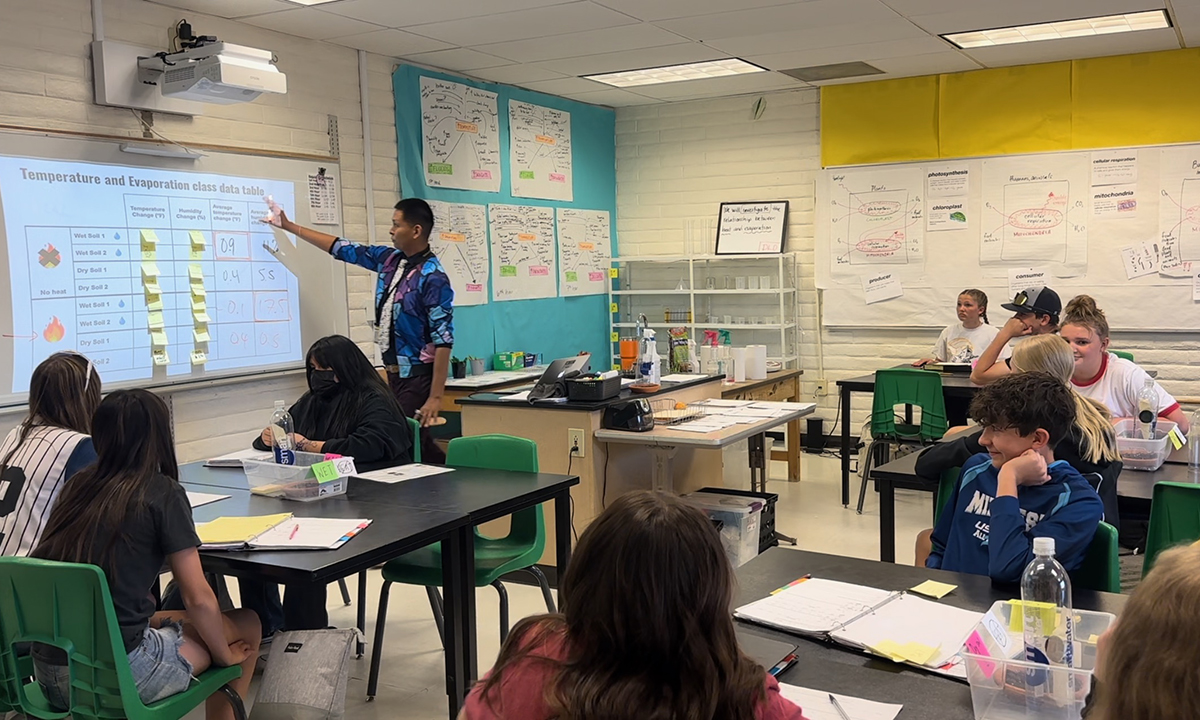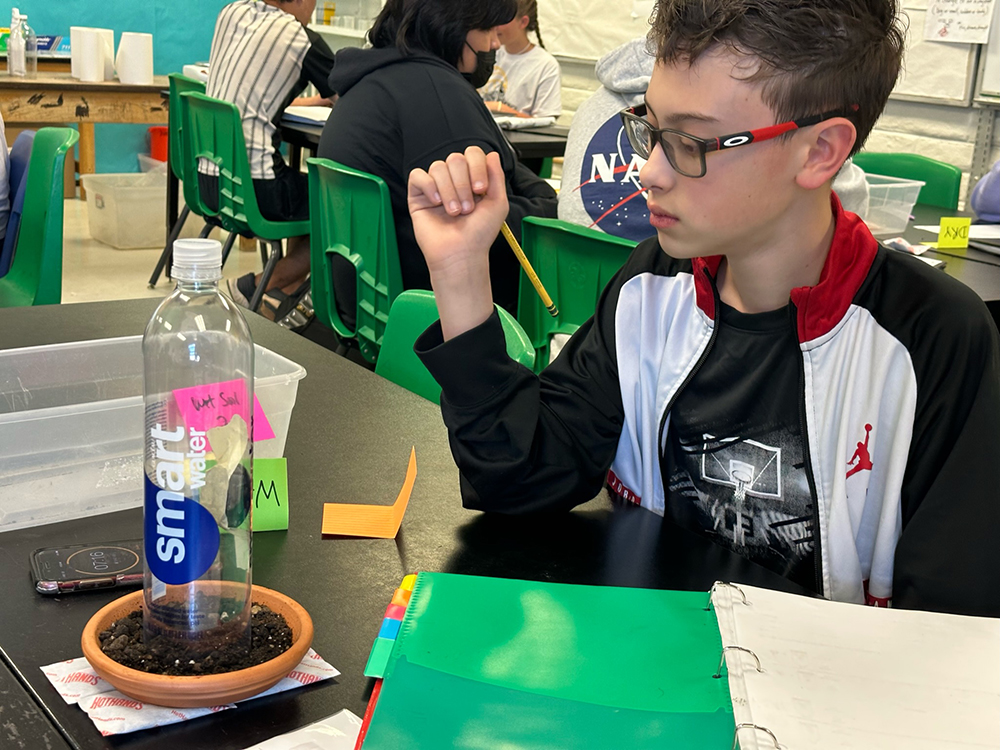New Mexico Teacher, Once a Lab Scientist, Applies Real Science to Lessons
With the implementation of high-quality curriculum OpenSciEd, students can learn as scientific investigators — like in the real world.

Get stories like this delivered straight to your inbox. Sign up for The 74 Newsletter
This is the fifth in a series of essays from a Knowledge Matters Campaign tour of school districts using high-quality science curriculum. Othell Begay, a seventh grade science teacher at Heights Middle School in Farmington, New Mexico, transitioned from a lab scientist to a science teacher when he moved home to New Mexico in 2012. In this piece, Begay explains how he was able to transform his science instruction and better engage his classes with the OpenSciEd curriculum, which encourages students to act as scientific investigators. Follow the rest of the series and previous curriculum case studies here.
My first career was not in teaching. I worked in an HIV Lab in New York City for five years before returning to my home in New Mexico in 2012. While away, I had developed a passion for science, and became convinced that one way I could make a contribution to the community I loved might be to help spark that passion in young people. I wanted to show students that science is more than the boring, read-and-take-notes course that I was subjected to in my youth.
And now, as more people express skepticism for data, I also want to help young people learn how you go about validating it; to understand that data is real and that understanding how to document and interpret it can give one real power.
When I began teaching, New Mexico was just preparing to transition to the Next Generation Science Standards. Our district didn’t have an aligned curriculum but, determined as I was to engage my students by sharing with them my lab experience, I embarked on designing lessons based on experimentation and data analysis. My results weren’t steller; the students were still bored. But my proof of concept came when I asked them to analyze video game data. It was here, in what they considered a relevant context, that they started to engage.
As I became more familiar with the performance expectations of the NGSS, my instinct about the importance of students really understanding data, and how to conduct analyses, was confirmed. Because unlike traditional science assessments that required little math knowledge, the new standards challenged students to analyze charts, graphs, maps and data sets — and to recognize patterns.
Video games notwithstanding, I struggled to find relevant data for students to use. I even attempted an assignment asking students to find local data and graphs, but that turned out to be far too complicated for middle schoolers. I spent long hours searching for information to fit the new standards, but my lesson plans often failed to engage the students. I found some good project-based lessons, but putting them in any kind of successive order felt disjointed and disconnected. Despite having good standards, understanding what they asked students to know and to be able to do, and with all the best of intentions, instruction in my classroom was still a bit of a mess.
Things changed in 2018, when a neighboring school in our district that was field-testing OpenSciEd middle school units offered to demonstrate lessons. Because I’d become a bit discouraged by my own less-than-successful efforts, I was excited to give it a try. Our New Mexico Public Education Department offered OpenSciEd workshops, for which I was very grateful.

What excited me the most about the OpenSciEd curriculum was that it’s modeled after real life scientific research. Standards that required students to memorize content knowledge were replaced by the new “Performance Expectations,” which, in addition to content knowledge, require the steps of scientific inquiry. Instead of teaching students to memorize the order —Observe, Question, Research, Hypothesis, Peer Review — OpenSciEd models the experience I had in the laboratory of solving problems.
When I was working in a lab, I would become consumed with figuring out a solution to the myriad problems I encountered along the way — and, as we began using the curriculum, I was delighted to see that this was the experience my students were having as well. They really took to their role as scientific investigators!
“It’s like a puzzle, it’s all out there, just sitting there, pieces broken off, it’s up to you to get that viewpoint,” eighth grade student Shawn Baker told our visitors from the Knowledge Matters Campaign. “Start with one piece and slowly add, add, add — until you have one big understanding.”
And, COVID couldn’t have been a more real-world example to demonstrate to our students the importance of solving problems by utilizing the scientific process. By the onset of the pandemic in early 2020, we collectively became consumed with the importance of scientific literacy and data sense-making.
Each lesson in the OpenSciEd curriculum asks students to look at information, analyze it, and ask themselves what makes sense and what doesn’t. We’re using science literacy skills to look at information and make evidence-based judgments. These are skills and attitudes I didn’t pick up until college. I am proud that I am helping my students learn this at such a young age. They know how to look at a problem and start solving it. If I were an employer, particularly if I were running a lab, I would absolutely be looking for people who have the skills my students are learning from this curriculum.
These are some of my lessons learned from adopting and implementing OpenSciEd over the years:
- Don’t be afraid to make the curriculum your own.
- There’s a lot of content in OpenSciEd and it can get overwhelming. We’ve all heard the expression, “Go slow to go fast.” That applies here.
- Students are doing the heavy lifting with this curriculum, and some of them might not be used to that much thinking. It may be tempting for teachers to revert to their traditional practice of giving students the answers and expecting them to retain it versus discovering it on their own. But investigating it on their own creates more engagement, which helps with information retention.
- Be careful what you omit (for pacing or other reasons). When I have omitted things in the past, I have often found that we’ve missed a crucial step in building student comprehension. Every year I teach this curriculum I appreciate more and more how thoughtfully it was constructed.
- Grading student work will take longer than in previous years, but it’s worth it. Because of the nature of what they’re doing, the work you’re reviewing provides a real opportunity to recognize where the students are in their understanding and use it to offer useful feedback.
My best advice is to go for it. Having every student in every class engaged and learning is the payoff. Our kids need and deserve to have science made meaningful to them in the way we’ve been able to with this curriculum.
Get stories like these delivered straight to your inbox. Sign up for The 74 Newsletter

;)